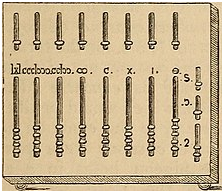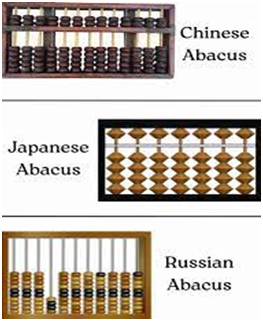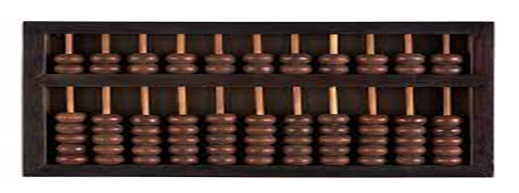HISTORY OF ABACUS
Why does the abacus exist?
The concept of counting without written numbers seems unimaginable, yet in ancient times, this was the norm. Initially, people relied on their hands and fingers to count up to ten things, while toes were also used in certain tropical cultures. However, as larger quantities needed to be counted, natural objects such as sea shells, pebbles, and twigs were utilised as counting aids. For merchants, keeping track of inventory was crucial, leading to the creation of portable counting devices such as the abacus. As the Hindu-Arabic number system emerged, abaci were adapted to facilitate place-value counting. Eventually, abaci were transformed into electro-mechanical calculators, pocket slide-rules, electronic calculators, and even digital representations of calculators or simulations on smartphones.
What is the difference between a counting board and an abacus?
It is crucial to differentiate between the ancient counting boards and the modern abaci. Counting boards were constructed from materials such as stone, metal, or wood, and featured carved grooves or painted lines to hold beads, pebbles, or metal discs. On the other hand, an abacus is a wooden device (although the Romans created metal ones, and plastic versions are used today) with a frame holding rods that slide freely, each containing beads.
While both the counting board and the abacus serve as mechanical tools for counting, they do not function as calculators in the contemporary sense. Users of the abacus carry out mental calculations and rely on the device as a physical aid to keep track of the addition, carrying, and other mathematical operations.
What did the first counting board look like?
The earliest counting boards are forever lost because they were constructed of perishable materials like wood.
Early writings of Plutarch and other sources offer insights into the potential design of counting boards. These boards were commonly employed in outdoor markets of the time and featured rudimentary methods of construction. For instance, one simple method of creating a counting board involved using fingers or a stylus to draw lines in the sand and placing pebbles between them to represent numbers (with spaces between the lines representing units of 10s, 100s, etc.). Wealthier merchants could afford small wooden tables with raised borders filled with sand (often blue or green). These tables offered the benefit of being portable, allowing them to be transported indoors without disrupting any ongoing calculations.
As the need for portable devices increased, wooden boards featuring grooves carved into the surface were developed, along with wooden markers acting as place-holders. Eventually, these wooden boards gave way to more durable materials such as marble and bronze, which were used with stone or metal markers.
The evolution of the counting device can be divided into three ages: Ancient Times, Middle Ages, and Modern Times.
• ANCIENT TIMES
The Salamis Tablet, the Roman Calculi and Hand-abacus are from the period c. 300 B.C.E. to c. 500 C.E.
- ROMAN ABACUS
- GREEK ABACUS


The oldest surviving counting board is the Salamis tablet (originally thought to be a gaming board), used by the Babylonians circa 300 B.C., discovered in 1846 on the island of Salamis.
• THE MIDDLE AGES
The Apices, the Coin-board and the Line-board are from the period c. 5 C.E. to c. 1400 C.E.

The “exchequer” derives is name from the chequered table which was used in England from c. 1100 for calculating expenditure and receipts.
Arithmetic brought about the invention of logarithms by John Napier and logarithmic scales by Edmund Gunter. In 1622, William Oughtred used these two inventions together and invented the slide rule which lasted until modern times when the scientific calculator became popular in the early 1970s.
• MODERN TIMES
The Suan-pan, the Soroban and the Schoty are from the period c. 1200 A.D to the present.

The Chinese name for the abacus, Suan-Pan, was documented around the year 1200 C.E. in China, and the original device was constructed using wood and reinforced with metal. The traditional Chinese abacus featured 2 beads on the upper deck and 5 on the lower deck of each rod, known as a 2/5 abacus. This style remained unchanged until approximately 1850, when the 1/5 abacus, with one bead on the top deck and five beads on the bottom deck, was introduced.
SOROBAN
Around the year 1600 C.E., the Japanese began utilizing and developing the 1/5 Chinese abacus, which they acquired through Korea. In Japan, this device is referred to as Soroban. Eventually, the 1/4 abacus emerged around 1930 and became the preferred style in Japan, where it is still produced today. As for the 1/5 models, they are now scarce, and the 2/5 models are uncommon outside of China, except for in Chinese communities located in North America and other regions.
SCHOTY
The Russian abacus is called a schoty (pronounced "SHAW-tee"). It was invented in the 17th century and is still in use today.
The design of the schotyis based on a pair of human hands (each row has ten beads, corresponding to ten fingers). The abacus is operated by sliding the beads right-to-left.
MESOAMERICAN ABACUS
In recent times, there have been proposals regarding the existence of an abacus utilized by the Aztec civilization, known as the Nepohualtzitzin, which was believed to have been used around 900-1000 C.E. This device featured counters made of maize kernels that were threaded through strings and mounted on a wooden frame. However, since it was made from materials that could decay over time, it is difficult to verify the actual existence of such a tool.
Moreover, there is ongoing controversy surrounding the purpose and function of the Incan Khipu. Some argue that it was a three-dimensional binary calculator, while others believe it was a form of writing, or possibly even both.
LEE KAI-CHEN ABACUS
Lee Kai-chen released a handbook in 1958, detailing his innovative abacus creation that incorporated four decks. This abacus fused two traditional designs, comprising a small 1/4 soroban as the top deck and a 2/5 suan-pan as the bottom deck. The author claimed that his modified abacus facilitated simpler multiplication and division operations, while also enabling calculations of square and cubic roots of numbers.
THE ABACUS TODAY
There are stores in China where merchants still use an abacus to tally a customer's bill. The photograph below, was taken by Ed Byrne in 2013, in a store in Hong Kong.

The abacus remains a prevalent tool among shopkeepers in Asia and in "Chinatowns" across North America. Additionally, it is still taught in Asian schools and a few schools in the Western world. Interestingly, the abacus is also utilized to teach blind children how to perform calculations, whereas their sighted counterparts learn to use pen and paper. Moreover, the abacus serves as an effective instrument for teaching young students basic math, particularly multiplication. This is a more engaging alternative to the tedious memorization of multiplication tables. Furthermore, owing to its versatility, the abacus is an excellent resource for teaching other base numbering systems.
Portable Computing Devices Today

The abacus, originally designed as a portable computing device, underwent a series of advancements, culminating in the creation of the slide-rule, which was the final mechanical innovation in the realm of portable calculating devices prior to the advent of digital calculators in the electronic age. In 1972, the introduction of the Hewlett Packard HP-35 scientific calculator made slide-rules obsolete.
Within a few decades, scientific calculators evolved into programmable models that could display graphs and images on bitmapped LCD screens. During the period in which pocket calculators were gaining popularity, the Sorocal/Sorokaru, a hybrid abacus digital calculator, was produced to assist abacus users in making the transition.
In the 21st century, portable counting devices are seldom stand-alone tools. Instead, they exist in the form of apps running on desktop computers, smartphones, and tablets. It is notable that, thousands of years after civilization began recording history with a stylus and clay tablets, these original terms are being re-utilized in modern times.

